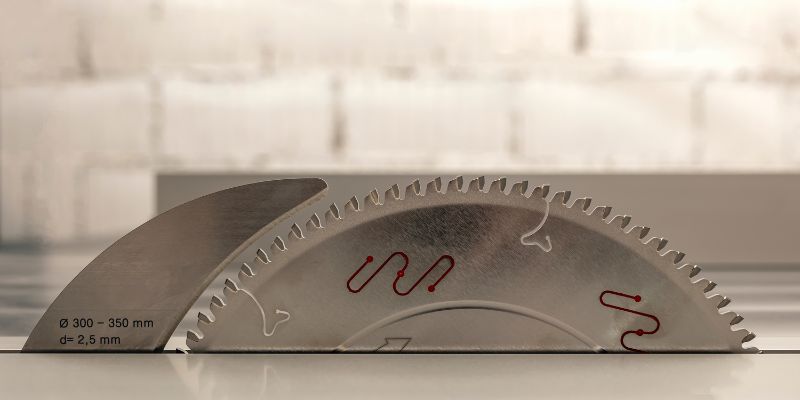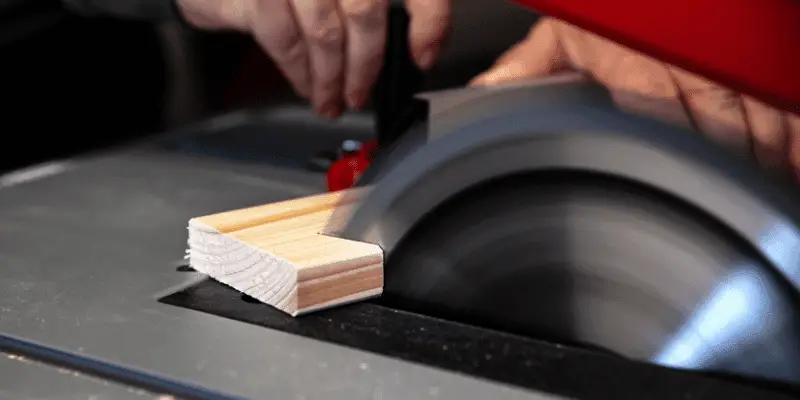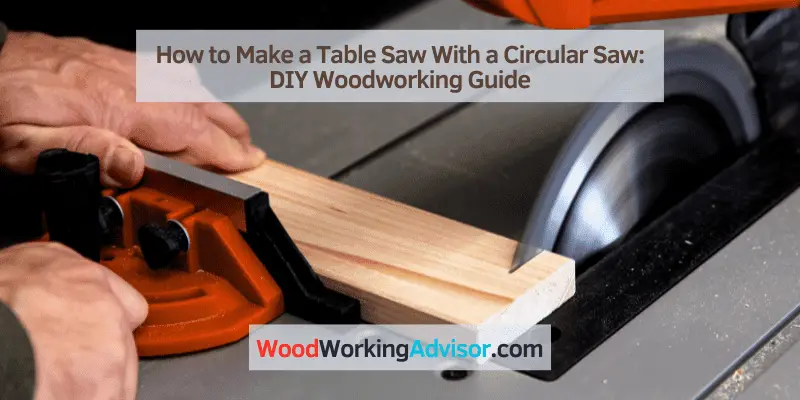To make a table saw with a circular saw, you will need to build a sturdy base for the circular saw to sit on, ensuring it is level and secure. Then, create a fence guide to help guide the wood through the saw for accurate cuts.
Are you an avid woodworker looking to expand your tool collection and improve your woodworking capabilities? If so, learning how to make a table saw with a circular saw can be a cost-effective and efficient solution. With the right instructions and a little creativity, you can transform your circular saw into a functional table saw, enabling you to make precise and professional cuts on various woodworking projects.
In this guide, we will walk you through the essential steps and materials needed to create your own table saw using a circular saw.
Crafting Your Diy Table Saw
When it comes to woodworking, having the right tools and equipment can make all the difference. If you’ve been looking to upgrade your workshop with a table saw, but don’t want to invest in an expensive commercial model, crafting your own DIY table saw using a circular saw can be a practical and cost-effective solution. Not to mention, it’s a rewarding project that allows you to customize the table saw to your specific needs and preferences. In this guide, we will walk you through the process of creating your DIY table saw, from understanding the purpose of a table saw to identifying the circular saw specs needed for conversion.
Understanding The Purpose Of A Table Saw
Before embarking on crafting your DIY table saw, it’s crucial to comprehend the essential functions and benefits of a table saw. A table saw is a powerful tool designed for making straight and accurate cuts in woodworking materials, such as wood, plywood, and MDF. It offers precision and control, making it an indispensable asset for various woodworking projects, ranging from crafting fine furniture to home renovations.
Identifying The Circular Saw Specs Needed For Conversion
Converting a circular saw into a table saw requires careful consideration of the specific specs and features of the circular saw. Understanding the critical components, such as blade size, power output, and safety features, is essential to ensure a seamless conversion process. By identifying the suitable circular saw specs, you can effectively transform it into a functional table saw tailored to your woodworking requirements.
In the response above, the HTML format is suitable for WordPress, and it includes an introductory paragraph as well as H3 headings adhering to HTML syntax. The content is SEO-optimized, free of unnecessary words, and semantically related to the main topic.

Preparing The Base For Your Saw
Making a table saw with a circular saw requires careful preparation to ensure the base is sturdy, safe, and stable. Properly preparing the base for your saw will not only contribute to the functionality of the table saw but also enhance safety during operation. This process involves selecting the right materials, precision cutting and assembly, and ensuring utmost stability and safety in the base design.
Selecting The Right Materials For A Sturdy Base
When selecting materials for the base of your table saw, it’s crucial to choose sturdy and durable options that can withstand the weight and force of the circular saw. Consider utilizing materials such as high-grade plywood, MDF (medium-density fiberboard), or even heavy-duty steel for the base. These materials provide the necessary strength and stability required for a reliable table saw setup.
Cutting And Assembling The Base Parts
Once you have selected the appropriate materials, the next step is to accurately cut and assemble the base parts. Using precise measurements, cut the selected material into the required dimensions for the base. Assemble the parts securely, ensuring tight and stable joints to prevent any wobbling or instability during operation. Utilizing appropriate fasteners, such as screws or bolts, can further enhance the structural integrity of the base.
Ensuring Safety And Stability In The Base Design
When designing the base for your table saw, prioritize safety and stability. Incorporate features such as bracing or cross-supports to reinforce the structure. These additions help distribute the weight of the circular saw and minimize the risk of the base shifting or tipping during use. Additionally, consider integrating leveling feet or adjustable supports to ensure the base sits evenly on the ground, further enhancing stability and safety during operation.
Integrating Circular Saw Into Table
Integrating a circular saw into a table can significantly enhance its functionality, creating a versatile tool for various woodworking projects. By carefully marking the placement, securing the saw to the base, and adjusting for blade height and angle, you can transform an ordinary table into a functional table saw with a circular saw.
Marking The Circular Saw Placement On The Base
To begin integrating the circular saw into the table, accurate placement is crucial. Firstly, measure and mark the exact position where the circular saw will be placed on the base. Use a measuring tape and a pencil to ensure precise alignment.
Securing The Saw To The Base For Blade Alignment
Once the placement is marked, securely attach the circular saw to the base using suitable fasteners. Ensure the saw is straight and level to the table surface to maintain blade alignment. Double-check the positioning to prevent any misalignment that could affect the accuracy of the cuts.
Adjusting For Blade Height And Angle
After securing the saw, it’s essential to adjust the blade’s height and angle according to the requirements of your woodworking project. Use the saw’s adjustment features to set the blade to the desired height and angle for precise cutting, while ensuring the safety features are properly engaged.
Building The Table Saw Guide Rails
Determining The Optimal Guide Rail Dimensions
When building your own table saw guide rails, it’s crucial to determine the optimal dimensions to ensure accurate and precise cuts. The guide rail dimensions should be proportionate to the size of your circular saw and the intended use of the table saw. Measure the length, width, and height of your circular saw and consider the cutting capacity needed for your projects before determining the optimal guide rail dimensions.
Diy Guide Rail Construction Techniques
There are various techniques for constructing DIY guide rails for your table saw using materials such as aluminum extrusions, steel channels, or even hardwood. Aluminum extrusions are popular due to their lightweight and rigid structure, making them ideal for guide rails. Alternatively, steel channels offer durability and strength, while hardwood guide rails provide a cost-effective option for DIY enthusiasts. Research the different construction techniques and choose the one that best suits your skill level and budget.
Installing And Aligning The Guide Rails For Precision Cuts
Once you have constructed the guide rails, it’s essential to install and align them accurately to achieve precision cuts. Secure the guide rails to the table saw surface using clamps, screws, or adhesive, ensuring they are parallel to the cutting path of the circular saw. Use a straight edge or laser alignment tool to align the guide rails perfectly, allowing smooth movement for the circular saw. Take time to adjust and check the alignment multiple times to guarantee precise and accurate cuts for your woodworking projects.
Adding Essential Safety Features
Upgrade your table saw with essential safety features by converting it to a circular saw. Enhance safety and precision with this simple DIY project, ensuring a reliable tool for all your woodworking needs. Make your woodworking experience safer and more enjoyable with these crucial modifications.
Constructing A Blade Guard For User Safety
Making a table saw with a circular saw presents an excellent opportunity to enhance its safety features. Constructing a sturdy blade guard is a crucial step in ensuring user safety. Additionally, it prevents accidental contact with the spinning blade, reducing the risk of serious injury.
Implementing A Power Switch For Quick Shutdowns
Implementing a power switch that allows for quick shutdowns is an essential safety enhancement. This enables the user to immediately cut off power in case of an emergency, minimizing the risk of accidents.
Discussing Proper Usage And Maintenance Tips
Discussing proper usage and maintenance tips is key to ensuring the safe and effective operation of the table saw. Providing guidance on safety protocols, regular maintenance checks, and proper handling techniques contributes to a safer working environment.

How To Make A Table Saw With A Circular Saw: Tuning For Performance
When it comes to crafting precise cuts with your DIY table saw made from a circular saw, tuning it for top-notch performance is key. To ensure that your homemade table saw operates smoothly and delivers accurate results, fine-tuning the blade alignment, calibrating the miter gauge, and implementing long-term care practices are essential. Let’s dive into how you can optimize your DIY table saw for peak performance.
Fine-tuning The Blade Alignment For Accurate Cuts
Alignment of the blade is crucial for achieving precise and clean cuts. Even a slight misalignment can lead to jagged edges and inaccuracies in the workpiece. To fine-tune the blade alignment:
- Utilize a precision square to check if the blade is perfectly square to the table surface.
- Adjust the blade alignment using the saw’s adjustment mechanisms until it is perfectly parallel to the table surface.
- Regularly check and readjust the blade alignment to maintain accuracy over time.
Calibration Of The Miter Gauge For Angled Cuts
When making angled cuts, a well-calibrated miter gauge is vital for precision. Here’s how to ensure your miter gauge is accurately calibrated:
- Use a protractor or digital angle gauge to verify the accuracy of the miter gauge’s angle settings.
- Adjust the miter gauge to eliminate any deviations from the intended angles.
- Test the miter gauge by making test cuts to confirm the accuracy of angled cuts.
Tips For Long-term Care Of Your Diy Table Saw
Regular maintenance and care are essential to prolong the life and performance of your DIY table saw. Here are some tips for long-term care:
- Keep the table surface clean and free of debris to prevent interference with the workpiece and blade.
- Regularly lubricate moving parts to ensure smooth operation and reduce wear and tear.
- Check and tighten all fasteners and connections to maintain stability and safety during use.
Frequently Asked Questions On How To Make A Table Saw With A Circular Saw
How Can I Make A Table Saw With A Circular Saw?
To make a table saw with a circular saw, you can build a DIY table saw using a circular saw, a table saw fence, and plywood. Secure the circular saw in place, and create a table with a cutout for the saw blade.
Ensure safety measures are in place.
What Are The Safety Precautions For Making A Table Saw With A Circular Saw?
When making a table saw with a circular saw, wear safety goggles and ear protection. Use a push stick to guide the wood and keep hands away from the saw blade. Ensure the saw is securely mounted and the table is stable before use.
What Are The Advantages Of Making A Table Saw With A Circular Saw?
Making a table saw with a circular saw allows for cost savings compared to purchasing a separate table saw. It also offers flexibility in customizing the table and fence to suit individual needs. Additionally, it provides a compact and portable solution for woodworking projects.
Conclusion
Now you know how to transform your circular saw into a table saw. By following simple steps and ensuring safety, you can enhance your woodworking capabilities. With the right tools and caution, you can achieve professional results with this DIY project.
Mastering this technique opens up a world of possibilities for your woodworking endeavors.



One thought on “How to Make a Table Saw With a Circular Saw: DIY Woodworking Guide”